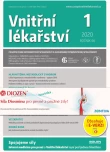Acute myocardial infarction in a male patient with metabolic syndrome and obstructive sleep apnea syndrome
Authors:
Jan Peterka; Hana Rosolová
Authors‘ workplace:
II. interní klinika UK, LF v Plzni a Fakultní nemocnice Plzeň
Published in:
Vnitř Lék 2020; 66(1): 44-48
Category:
Case Report
Overview
A casuistic of a male, obese smoker, to whom the syndrom of obstructive sleep apnea (OSA) was diagnosed at his age of 32 years, was suffering from acute myocardial infarction at his 50 years. The patient had fulfilled all criteria of metabolic syndrome during time of acute heart attack: visceral obesity, arterial hypertension, mixed dyslipidemia, and type 2 diabetes mellitus. He was never examined by routine screening and then not treated. This patient ranked to the very high total cardiovascular risk subjects before the acute event occured. The growing evidence suggests that OSA may contribute to the metabolic derangements that characterized the metabolic syndrome and high cardiovascular risk. It follows that after syndrome OSA determination, standard risk factors for metabolic syndrome and atherosclerotic cardiovascular disease should be asessed and start preventive lifestyle recommendations and treatment.
Keywords:
myocardial infarction – obstructive sleep apnea syndrome – metabolic syndrome
Sources
1. Alberti KG, Eckel RH, Grundy SM et al. Harmonizing the Metabolic Syndrome: a Joint Interim Statement of the International Diabetes Federation Task Force on Epidemiology and Prevention; National Heart, Lung, and Blood Institute; American Heart Association; World Heart Federation; International Atherosclerosis Society; and International Association for the Study of Obesity. Circulation 2009; 120: 1640–1645.
2. Rosolová H. Metabolický syndrom a jeho význam v primární prevenci nemocí s častým výskytem v populaci. CorVasa 2011; 53: 249–252.
3. Gottlieb DJ, Yenokyan G, Newman AB et al. Prospective study of obstructive sleep apnea and incident coronary heart disease and heart failure: the Sleep Heart Health Study. Circulation. 2010; 122: 352–360.
4. Mach E, Baigent C, Catapano AL et al. TaskForceMembers: 2019 ESC/EAS Guidelines‑ forthe management of dyslipidaemias: lipid modification to reduce cardiovascular risk. The Task Force for the management of dyslipidaemias of the European Society of Cardiology (ESC) and European Atherosclerosis Society (EAS). European Heart Journal (2019): 1–78.
5. Tietjens JR, Claman D, Kezirian EJ et al. Obstructive Sleep Apnea in Cardiovascular Disease: A Review of the Literature and Proposed Multidisciplinary Clinical Management Strategy. J Am Heart Assoc. 2019; 8(1): e010440.
6. Heinzer R, Vat S, Marques‑Vidal P et al. Prevalence of sleep‑disordered breathing in the general population: the HypnoLaus study. Lancet Respir Med. 2015;3(4):310–318
7. Mansukhani MP, Covassin N, Somers VK. Apneic Sleep, Insufficient Sleep, and Hy‑ pertension. Hypertension. 2019; 73: 744–756
8. Martínez‑García M, Capote F, Campos‑Rodríguez F et al. Effect of CPAP on Blood Pressure in Patients With Obstructive Sleep Apnea and Resistant Hypertension: The HIPAR‑ CO Randomized Clinical Trial. JAMA. 2013; 310(22): 2407–2415.
9. Gami AS, Hodge DO, Herges RM et al.Obstructive sleep apnea, obesity, and the risk of incident atrial fibrillation J. Am Coll Cardiol 2007; 49: 565–571.
10. Kanagala R, Murali NS, Friedman PA et al. Obstructive sleep apnea and the recu‑ rrence of atrial fibrillation. Circulation. 2003; 107: 2589–2594.
11. Zhang L, Hou Y, Po SS. Obstructive Sleep Apnoea and Atrial Fibrillation. Arrhythm Electrophysiol Rev. 2015; 4(1): 14–18.
12. Simantirakis EN, Schiza SI, Marketou ME et al. Severe bradyarrhythmias in patients with sleep apnoea: the effect of continuous positive airway pressure treatment: a long‑term evaluation using an insertable loop recorder. Eur Heart J. 2004; 25: 1070–1076.
13. Gami AS, Olson EJ, Shen WK et al. Obstructive sleep apnea and the risk of sudden cardiac death: a longitudinal study of 10,701 adults. J Am Coll Cardiol. 2013; 62(7): 610–616.
14. Peppard PE, Young T, Palta M et al. Longitudinal study of moderate weight change and sleep‑disordered breathing. JAMA. 2000; 284(23): 3015–3021.
15. Foster GD, Sanders MH, Millman R et al. Obstructive sleep apnea among obese pati‑ ents with type 2 diabetes. Diabetes Care. 2009; 32(6): 1017–1019.
16. International Diabetes Federation. The IDF Consensus Statement on Sleep Apnoea and Type 2 Diabetes. Dostupné z WWW:https://www.idf.org/e‑library/consensus‑statements/62idf‑consensus‑statement‑on‑sleep‑apnoea‑and‑type-2-diabetes.html
17. McEvoy RD, Antic NA, Heeley E et al. CPAP for Prevention of Cardiovascular Events in Obstructive Sleep Apnea. N Engl J Med 2016; 375: 919–931.
Labels
Diabetology Endocrinology Internal medicineArticle was published in
Internal Medicine

2020 Issue 1
Most read in this issue
- Sarcopenic obesity – current view
- Chronic stress, mental discomfort, and depression increase the rates of infectious, autoimmune as well as malignant diseases
- Odešel velký člověk a lékař prof. MUDr. Vítězslav Kolek, DrSc., FCCP
- Mandibular pain and deformation as a presentation of fibrous dysplasia of the mandible
